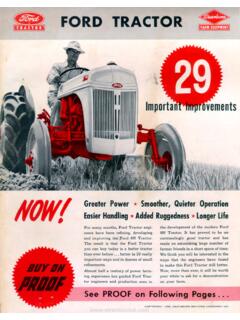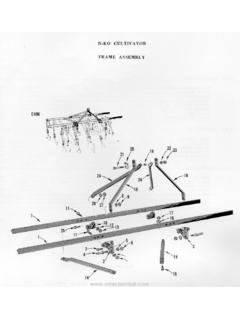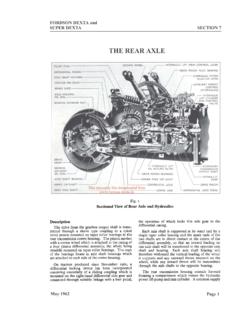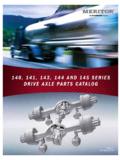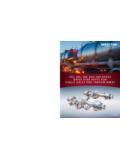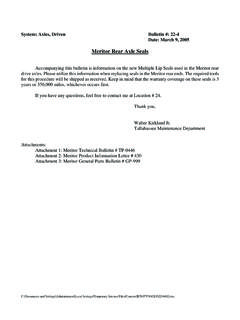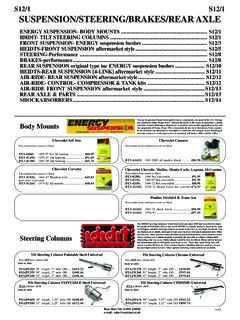Transcription of Replacing Rear Axle Seals in 8N Ford Tractors
1 Replacing 8N rear axle Seals - by John Smith #q15 rear axle Seals leaking gear lube onto the rear brake shoes and onto the wheel rim is very common on 8Ns, especially the early models before the added inner seal . The major causes of seal leakage are improper (loose) axle bearing preload and worn (loose) hubs on the axle shafts. Installing the correct number of shims to obtain proper bearing preload when Replacing Seals is critical, as is having good hubs. If your hubs were loose on the axles before, they will probably need replaced.
2 Once the hubs get worn, they will no longer tighten against the taper splines on the axles and you'll never stop the leaks. I have very rarely had to replace an axle shaft - severe wear from loose hubs has always been in the hub itself and the harder axle shaft was still good. You may not be so lucky. Inspect the hubs and axle shafts closely for wear. If your hubs were tight on the axle and required some force to remove them, they are most likely ok. Replacing the Seals is not too hard of a job if you're used to working on old rusty mechanical things and have some basic tools.
3 Here's a short rundown. It's not meant to replace the I&T FO-4 shop manual for the 8N. You will need the manual on hand before you ever start Replacing the Seals . Refer to it as you go. A common sight, the oil soaked rear brake drum on an 8N If your tractor is a '48 or'49, you have just one outer seal . If you have a '50 - '52 you have an outer and an inner seal . You will need the (Ford part number) A8NN4248A retainer assembly. This is actually the outer seal . The seal is pressed into the retainer. You will need the 8N4284 gasket and the 8N4225 gasket.
4 That's it, unless you have the '50 or later model in which case you will also need the 8N4233A inner seal . First, remove the retainer wires and loosen the hub center nuts about 1 turn. Rock the rear wheel from side to side. If the hub doesn't move on the axle , drive the tractor around for a few minutes. Do some figure 8's. Sometimes this will loosen the hub from the axle taper and save you from having to use a large puller. If they still don't appear to be loose on the axle , go ahead and remove the lug nuts and rear wheel. Remove the brake drum (the 4 flat head screws holding the drum to the hub can be a bear to remove if they're rusted in - and they usually are).
5 Remove the brake shoes. Pull the hub off, if it's loose. If it's not, get a large 3 jaw puller and start tightening. Make sure to leave the hub retaining nut on the axle but have it a couple of turns away from the hub. Without the nut, the hub can pop off suddenly and do some serious damage to your knee caps. Put pressure on the puller and tap the hub. Some are really on there and I've even had to resort to heat from a torch to get them to pop loose. Once it's off, remove the 6 bolts holding the retainer and seal assembly and pull it off.
6 The brake shoe pivot plate will come off now. Remove the last 2 bolts from behind (tractor side) and pull the bearing retainer and backing plate and slide the axle out to get access to the inner seal ('50-'52). Remove and replace the inner seal . The inner seal on the '50 - '52 models On early models, removing the backing plate and axle is somewhat unnecessary, but you should go this far anyway to reseal the area where grease can leak between the backing plate and axle housing flange and also make sure you have the right amount of shims to properly load the axle bearings.
7 Disassembled and ready to clean This is the time to inspect the axle bearing and cup for wear and to reset the axle bearing load. Make sure the bearing looks good, no pits in the cup or on the rollers. Make sure the backing plate, bearing retainer, and all shims and/or gaskets are clean. I select the shims needed to load the axle bearings to zero load. Zero is hard to describe. It's no bearing load and no end play. If you're not sure how many shims to use, follow the procedure in the shop manual to set the load. I think their procedure loads the bearings a little too tight, but it's worked ok for a lot of years, so who am I to question it.
8 Zero load is desired, but if you're in doubt, a little too loose is better than too tight. Too tight will ruin the bearings. Too loose will let the Seals leak again. Setting the axle bearing preload with the shims is a commonly misunderstood procedure. Remember you are adjusting the total preload for both axle bearings. The axles butt together in the center of the differential and have a tapered bearing on each outside end. The total number of shims determines the preload and each shim affects both axles equally. You're not setting each side, you're setting the total.
9 A good hub to axle fit is critical to the repair because worn hubs are the biggest cause of leaking Seals . Here's how the splines should fit between the hub and axle - flush with each other when the hub is seated tightly in place on the splines. If the axle splines protrude past the hub splines the hub is worn. If the axle splines protrude far enough the washer will bottom out and you cannot tighten the hub onto the axle . The hub will also rub on the center of the bearing retainer. In that case, the hub is definitely shot and must be replaced.
10 Here's the inside end of an axle that had too few shims installed. The bearing load was too tight and the axles butted together too tightly in the center. Besides destroying the axle bearings, the butt ends got hot enough to melt and smear the steel. Don't load them too tight. Be sure to pack the axle bearing with grease before you reassemble if you have the later model with inner seal . Clean all parts in a good solvent. Cleaned up and ready to assemble Reassemble with some Permatex Ultra Blue silicone RTV on all flange faces and wherever grease could leak out.



